 |
||||||||||||||||
| virtual Studio | References | Workshops | Styles of Frames | History | Collection | Gallery | ||||||||||||
|
|
||||||||||||||||||
|
Special Projects |
| |
|
|
||
|
Custom-made jewellery showcase In order to display and protect valuable jewellery appropriately this special showcase was produced. It is made up of a backboard that is firmly screwed to the wall. The showcase itself is swivel-hinged to this backboard so that the contents can be viewed from every angle. To prevent the showcase simply being lifted off the backboard special hinges were used. The contents are protected from the front by unbreakable safety glass. If the showcase is swung completely out, its rear panel can be unlocked with a key, a door opened and the contents of the showcase removed. The copper ornaments on the front of the showcase were supplied by the customer and included according to his wishes. The showcase itself was fashioned in red in accordance with an original, and then varnished to a high gloss. |
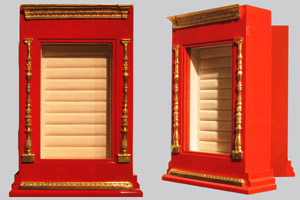  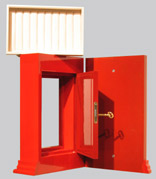 |
|
|
|
||
49th Munich Art Show In 2004 our workshop was again invited to take part in this Art Show, the most prestigious of its kind in Germany, and to put on view examples of our abilities in the field of reconstruction of historical picture frames. Examples of the restoration of priceless frames, and painted and gilded furniture were also put on show. |
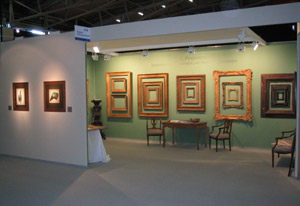 View of the Karl Pfefferle Workshop for Frames and Restoration booth at the Munich Art Show 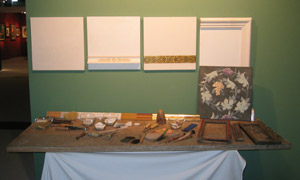 Tools and other work materials needed for the frame reconstructions done in accordance with our originals were also on display at our booth. |
|
|
|
||
Wall mount for an ancient gong This wall mount for a Chinese gong was designed and built by us. High quality teak was used in its construction. |
 |
|
|
|
||
Restoration of a Rococo frame Picture 1 (condition beforehand): - extremly dirty surface - defects in the frame Picture 2 (intermediate condition): - cleaned state, frame stabilised with sturgeon glue - frame defects filled and levelled Picture 3 (finished condition): - floral painting retouched |
.jpg) .jpg) .jpg) |
|
|
|
||
|
|
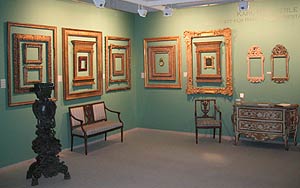 View of the Pfefferle Workshop for Frames and restoration booth at the Munich Art Show 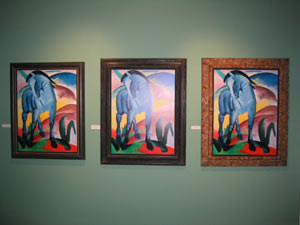 The original picture framed by the Pfefferle buisness, is hanging in the Lenbach House in Munich |
|
|
|
||
Framing of a piece of Coptic embroidery The piece of fabric was carefully sewn onto some linen affixed to stretcher. The frame was overlaid with the same tyre of linen, as was the spacing strip that maintained clearance between the glass and the artwork. In order to protect the ancient piece of fabric an anti-reflection coated, shatterproof UV protective glass was used. In this way an optically subdued, protective framework was achieved that met all conservatic concerns. |
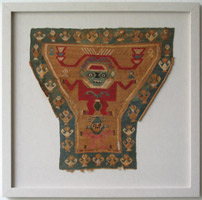 |
|
|
|
||
Custom made table produced according to customer specifications Starting point for this assignment was a small sketch, hand-drawn by the customer. After an on-site inspection, the measurements and the design were decided upon. The table was manufactured in oak veneer, and the colour tone was mixed on-site together with the customer. As a preferably hard, resilient surface was required, the table was varnished in a paint shop with a clear, abrasive and scratch resistant varnish. |
 |
|
Exhibition in the Salzburg Baroque Museum Picture frames in Baroque In teamwork with Karl Pfefferle and the art historian Christian Burchard, the Salzburg Baroque Museum exhibited picture frames from the 16th and 17th centuries. The main focus of the exhibition was on frames from the South German Baroque and French frames. For comparison examples from Italy, Spain and the Netherlands were chosen. A classification of the frames according to art historical and technical aspects was worked out. Especially printed information with an introduction to Baroque reports, issue 24/25, was released in timing with the exhibition. The special brochure can be ordered at a small charge of 5 €. (From the catalogue:) Frames are “historical comments” even in the modern sense. “Historical” in as far as the language of ornaments is older than motif painting, as Ortega y Gasset quite rightly emphasised in his meditations about frames. Long before the development of a protective frame for a transportable picture in the 15th century, picture motifs in frescos and mosaics were embedded as emblems in a decorative framework in order to accentuate their meaning or their symbolic character. However, the reason for the use of frames across epochs and cultures lies on a perceptional-psychological level. “Without a framework already in existence …we cannot understand the world”, says Ernst Gombrich, and describes how the frame satisfies the elementary sense of order of visual perception, even suggesting that without some form of “framework” a conscious perception is not possible. (Christian Burchard) |
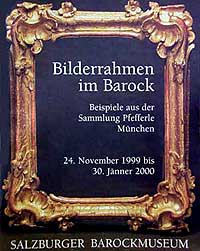 Poster for the exhibition in the Salzburg Baroque Museum. South German moulded frame, 2nd half 18th century, foliate gilding on red bole, carvings in linden wood. 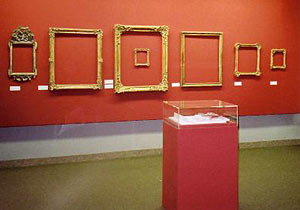 View into the exhibition room at the Salzburg Baroque Museum with examples of picture frames from the South German area. |
|
|
|
||
The Pfefferle Workshop for Frames Documentary film by Ursula Bushnell Bavarian Broadcasting Service - Channel 3, 18.5.1998 Within the framework of the broadcast “Historical Workplaces”, the Munich film director Ursula Bushnell directed a 30-minute documentary film about the Pfefferle Frame Workshops for Bavarian Television’s Channel 3. |
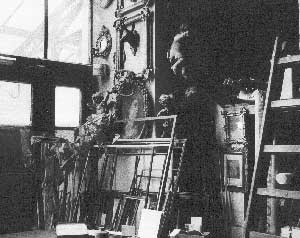 |
|
|
Camera
Sound Cutting Editing |
Peter Carstiuc Ralp P. Bemmann Gisela Gerlach Karl Strobel |
|
